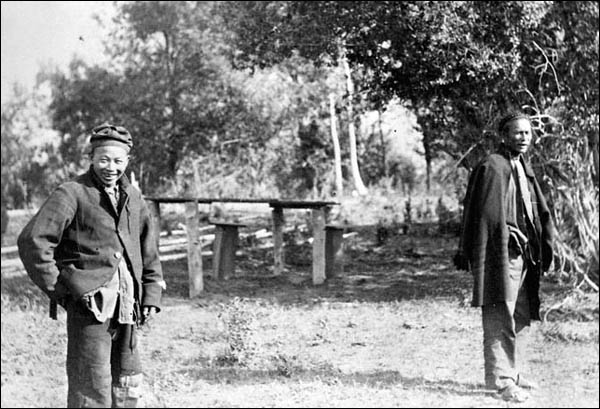Other Ethnic Groups
Although 19th-century Newfoundland and Labrador was not a very multicultural place, small numbers of immigrants did arrive from areas outside of the British Isles. Most prominent among these were the Chinese, Lebanese, and Jewish immigrants who arrived during the latter decades of the 1800s. These men and women left their homes for a wide range of economic and social reasons, the most common of which were to seek better employment or escape unfriendly government regimes and religious strife in their points of origin.
Once in Newfoundland and Labrador, many immigrants opened private businesses, such as laundries, shops, photography studios, and movie theatres, or obtained employment in the forestry and mining industries as well as in the fishery. Language barriers often restricted the nature of work many immigrants were able to perform, while cultural differences sometimes resulted in frictions between long-term residents and newcomers. Although most immigrants settled in larger commercial or industrial centres, smaller numbers also moved into outport communities.
Chinese Immigrants
Most Chinese immigrants to Newfoundland and Labrador came from Guangdong (also known as Canton Province) in southern China – a mountainous area where farming was difficult and poverty widespread. Ports in this region were among the country's first to open to foreign trade in the late 1800s, placing local residents in direct contact with westerners for the first time. Some Chinese obtained passage on visiting vessels and crossed the Pacific Ocean to settle in North America, where many hoped to earn a better living.
Most immigrants disembarked at Vancouver, where they could either remain or continue east. Those wishing to enter Newfoundland and Labrador had to travel by rail to Halifax and then board a steamer to the island of Newfoundland. Because the Canadian government imposed a head tax of $50 on Chinese immigrants after 1885 (which it raised to $500 in 1903), mounted police escorted Newfoundland-bound immigrants for much of their journey east to ensure they did not try to covertly settle in Canada.

The earliest known Chinese immigrants to Newfoundland and Labrador arrived during the mid-1890s and established hand laundries in St. John's. By 1904, three such businesses are known to have existed in the city – the Sing Lee Laundry on New Gower Street, the Jim Lee Laundry on Duckworth Street, and the Kam Lung Laundry on Cochrane Street. Laundry work was popular among early immigrants because it required no knowledge of English and, due to its labour-intensive nature, employed many workers. Although an accessible occupation, it was also difficult. Early each morning, workers visited homes to collect dirty clothes, which they brought to the laundry to hand-wash and iron before delivering them back to the owners. Workers carried the clothes in large bags and travelled around the city by foot, regardless of weather. They sometimes worked up to 20 hours a day and, although able to earn a decent living, were not rich and had little time for leisure.
As more Chinese arrived at Newfoundland and Labrador during the late 19th and early 20th centuries, competition for laundry work increased and many immigrants sought other kinds of employment. Most found jobs as gardeners, domestics, miners at the Bell Island iron ore mines, or as shoreworkers in the fishery.
While most immigrants settled at St. John's, smaller numbers moved to Harbour Grace, Carbonear, and elsewhere on the island. Wherever they settled, however, Chinese immigrants entered an almost exclusively white and English-speaking Christian society of mostly English or Irish descent. This created frequent problems for the Chinese, who rarely spoke English upon arrival, often practiced Buddhism or Taoism, and belonged to a visible minority. Children and sometimes even adults threw mud or other objects at them, broke their store windows, and mocked their appearance and traditions.
Some people were suspicious of the Chinese because they did not understand their culture, while others worried the new arrivals would take jobs away from long-term residents. This concern helped prompt the Newfoundland and Labrador Legislature to pass an Act Respecting the Immigration of Chinese Persons in 1906, which imposed a head tax of $300 on all Chinese people entering Newfoundland and Labrador, excluding clergymen, tourists, and members of the diplomatic corps. Students were reimbursed their fee if they studied in the country for three years immediately after arrival.
About 330 immigrants paid the tax before the government abolished the Act in 1949. The provincial government apologized for the legislation on 28 June 2006, stating the tax “was clearly discriminatory, and created both economic and emotional hardship for Chinese immigrants at that time.” The apology came about a week after the Canadian government apologized for the head tax it imposed on Chinese immigrants after 1885.
Lebanese Immigrants
Immigrants from Mount Lebanon arrived at Newfoundland and Labrador – and elsewhere in North and South America – during the late 19th and early 20th centuries to escape religious persecution, poverty, and military conscription within the Turkish Empire. Most immigrants first landed at Ellis Island in New York Harbour before proceeding to Nova Scotia and then across the Cabot Strait to Newfoundland. These men and women initially referred to themselves as Syrians, Assyrians, or Maronites, but assumed the designation Lebanese after the Republic of Lebanon formed in 1920.
Although a scarcity of existing research into the Newfoundland and Labrador Lebanese community makes it difficult to determine exactly how many immigrants arrived at the country, where they settled, and what they did, the 1911 Census enumerated 86 Syrians and 44 Turks. Most Lebanese settlers were active in commerce and belonged to a prosperous merchant class. Many opened shops, hotels, movie theatres, and a variety of other businesses, which prompted them to settle in commercial or industrial areas, including St. John's, Bell Island, and in western portions of the island. Anthony Tooton, for example, founded a successful chain of photography stores shortly after arriving at St. John's in 1904, while successful businessman Michael Basha ran the Bay of Islands Light and Power Company.

According to folklorist John Ashton, many Lebanese immigrants anglicized their first and last names upon arriving in North America, likely to accommodate their English-speaking neighbours. Ablain Andrea, for example, changed his name to Albert Andrews, while Jersus Karbaj changed his to George Corbage. Other anglicized names include Alteen (originally El Teen), Kelly (Khalil), Murphy (Miffleh), and Tooton (Tootonji).
Jewish Immigrants
About two million Jewish people emigrated from Eastern Europe to North America between 1881 and 1910 to escape anti-Semitic violence and rioting following the assassination of Czar Alexander II. While most immigrants settled in New York City and other large American centres, small numbers also arrived at Newfoundland and Labrador. Although little is yet known about early Jewish settlers, it appears that many engaged in trade and commerce, opening shops and working as peddlers.
Most peddlers sold small comforts not always available from merchant stores, including jewelry, stationery, pencils, combs, ties, handkerchiefs, tobacco, tea, shirts, and pocket knives. Before accumulating enough money and experience to open their own shops, many peddlers travelled by foot or coastal steamer with their merchandise and sometimes covered up to 32 kilometres a day. Although profits were low – most merchandise sold for about 20 per cent above wholesale – the work allowed them to gain experience and learn the English language, including a variety of complex local dialects.
Many Jewish immigrants may have found it difficult to settle in a predominantly English-speaking Christian society where few visible minorities existed. Alongside language and religious barriers, adhering to a kosher diet in 19-century Newfoundland and Labrador was likely a daily problem for early settlers. In response, many families appear to have converted to the Christian faith and attended various churches available on the island. This changed during the early decades of the 20th century, as more Jewish immigrants settled in Newfoundland and Labrador and the country's first synagogue opened on Water Street sometime between 1909 and 1915.




